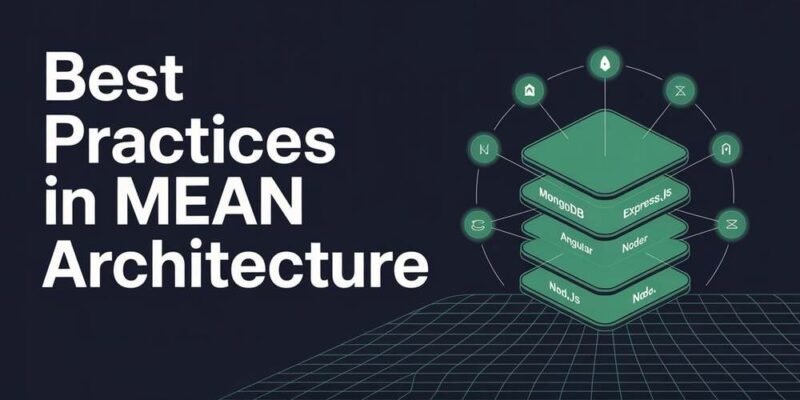The MEAN stack, MongoDB, Express.js, Angular, and Node.js, has become a go-to framework for building modern web applications. Its all-JavaScript environment streamlines development and delivers robust, scalable applications. If you want your project to succeed with MEAN, following best practices in its architecture is essential. This ensures your app is maintainable and secure and performs well over time.
In this article, we’ll explore practical architectural tips that every developer and team should keep in mind. Whether you’re just starting with MEAN or optimizing an existing project, these insights will help you build with confidence.
Understanding MEAN Architecture
Before diving into best practices, let’s briefly revisit what MEAN architecture involves. MEAN stack development services focus on a four-layered approach:
- MongoDB: The NoSQL database stores data flexibly in JSON-like documents.
- Express.js: A minimal backend framework for building APIs and handling server logic.
- Angular: The frontend framework responsible for dynamic user interfaces.
- Node.js: The server runtime environment handling requests and running Express.
Together, these layers create a seamless, JavaScript-driven flow from the database to the user interface.
Structuring Your MEAN Application
Structuring your MEAN application effectively creates a clear, organized codebase that simplifies development and testing. It enables better collaboration among team members by reducing overlap and confusion, making it easier to manage features and troubleshoot issues. A solid structure also supports scalability and long-term maintenance.
Organize by Feature, Not Just by File Type
- Group files by their features or modules (e.g., user, product, auth) rather than strictly by type (models, controllers).
- This approach keeps related code together and helps maintain separation of concerns.
- It also simplifies the addition of new features without overwhelming the project structure.
Separate Client and Server Code
- Maintain distinct directories for frontend (Angular) and backend (Express/Node.js) code.
- This separation makes it easier to manage dependencies, testing, and deployments.
- It also clarifies responsibilities for developers working on specific parts of the stack.
Optimize MongoDB Usage
MongoDB’s flexible schema is robust but requires careful handling to keep your app fast and reliable. Proper indexing and thoughtful schema design are crucial for optimizing query performance. Avoiding unnecessary data retrieval helps maintain efficiency and ensures your application scales smoothly as it grows.
Design a Thoughtful Schema
- Although MongoDB allows schemaless storage, it is recommended to define a consistent schema with validation to ensure data integrity.
- Use embedded documents for related data that are frequently read together.
- Use references when dealing with complex relationships or large datasets to ensure accuracy and consistency.
Use Indexes Wisely
- Create indexes on fields commonly queried to improve read performance.
- Avoid excessive indexing as it can slow down write operations.
- Regularly monitor query performance and adjust indexes accordingly.
Build Modular and Scalable APIs with Express
Express forms the backbone of your server-side logic. Clean, modular code here sets the tone for the whole app.
Use Middleware Efficiently
- Apply middleware functions to handle repeated tasks such as authentication, logging, or error handling.
- Keep middleware focused and lightweight to maintain responsiveness and efficiency.
Keep Routes Simple and Organized
- Break routes into separate modules based on functionality.
- Use RESTful conventions to create predictable endpoints.
- Handle errors centrally to avoid duplicated error-handling logic.
Angular Best Practices for Frontend Architecture
The front end has a direct impact on user experience. An efficient Angular architecture enhances responsiveness and facilitates easy updates. Organizing your app into modular components and leveraging Angular CLI tools can streamline development. Adopting lazy loading and change detection strategies further boosts performance and maintainability.
Modularize Your Application
- Organize Angular modules by feature and lazy-load modules that aren’t needed immediately.
- This improves initial load times and maintains the app’s responsiveness.
Use Reactive Forms and State Management
- Reactive forms offer better control and validation.
- Consider state management solutions like NgRx for complex apps to handle data flow predictably.
Manage Environment and Configuration Settings
Keeping configuration separate from code makes your app easier to deploy and maintain.
Use Environment Files
- Store environment-specific variables like API URLs or database connections outside your source code.
- Angular supports different environment files for development and production.
Secure Sensitive Data
- Use .env files for server-side secrets and API keys.
- Avoid committing sensitive information to source control.
Version Control and Collaboration
Efficient version control workflows help teams deliver code faster and with fewer conflicts.
Adopt Branching Strategies
- Use feature branches to isolate new work.
- Regularly merge changes to avoid long-lived branches.
Code Reviews and Pull Requests
- Encourage peer reviews to maintain code quality.
- Utilize automated tools to identify and resolve formatting and linting issues before manual review.
Testing and Quality Assurance
Tests catch bugs early and improve application reliability.
Automate Unit and Integration Tests
- Use tools like Jasmine and Karma for Angular testing.
- Use Mocha or Jest for backend testing.
Write End-to-End Tests
- Simulate user flows to validate app behavior using tools like Protractor or Cypress.
Performance Optimization
A fast app keeps users engaged and improves SEO.
Implement Caching Strategies
- Use HTTP caching headers for static content.
- Consider Redis or in-memory caching for frequently accessed data.
Optimize API Calls
- Minimize unnecessary network requests.
- Batch or debounce calls where appropriate.
Security Considerations
Security must be built into your MEAN stack app from the ground up.
Sanitize Inputs
- Prevent injection attacks by validating and sanitizing user inputs.
Use Helmet and Security Middleware
- Secure HTTP headers to mitigate common vulnerabilities.
Implement Robust Authentication
- Use JWT tokens or OAuth to secure API endpoints.
- Enforce role-based access controls.
Monitoring and Logging
Tracking your application’s health allows quick detection and resolution of issues.
- Integrate logging solutions, such as Winston, for backend logs.
- Utilize monitoring tools like New Relic or Datadog for performance insights.
Conclusion
Best practices in MEAN architecture are crucial for developing scalable, maintainable, and high-performance web applications. Following these guidelines ensures that your project is well-structured, secure, and efficient, ultimately delivering a better experience for both users and developers. Achieving this level of quality requires expertise and a strategic approach to development.
That’s where Codewave comes in. As a trusted technology partner, Codewave collaborates closely with clients to design and implement MEAN stack solutions that align with their specific business needs. Their skilled team brings deep experience in MEAN architecture, focusing on optimization, security, and seamless integration to help projects succeed from start to finish.
Contact Codewave today to start the conversation.
Do Read: SaveFrom.net: Your Go-To for FB Video Downloads & Sharing on Disboard













